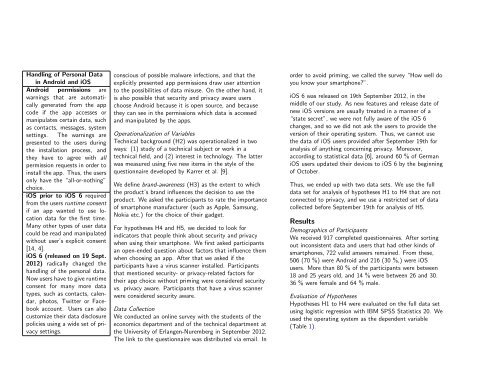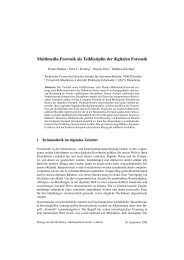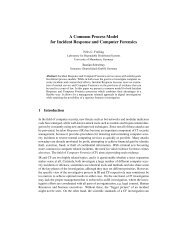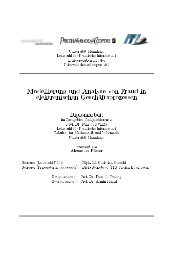Android and iOS Users' Differences concerning Security and Privacy
Android and iOS Users' Differences concerning Security and Privacy
Android and iOS Users' Differences concerning Security and Privacy
You also want an ePaper? Increase the reach of your titles
YUMPU automatically turns print PDFs into web optimized ePapers that Google loves.
H<strong>and</strong>ling of Personal Data<br />
in <strong>Android</strong> <strong>and</strong> <strong>iOS</strong><br />
<strong>Android</strong> permissions are<br />
warnings that are automatically<br />
generated from the app<br />
code if the app accesses or<br />
manipulates certain data, such<br />
as contacts, messages, system<br />
settings. The warnings are<br />
presented to the users during<br />
the installation process, <strong>and</strong><br />
they have to agree with all<br />
permission requests in order to<br />
install the app. Thus, the users<br />
only have the “all-or-nothing”<br />
choice.<br />
<strong>iOS</strong> prior to <strong>iOS</strong> 6 required<br />
from the users runtime consent<br />
if an app wanted to use location<br />
data for the first time.<br />
Many other types of user data<br />
could be read <strong>and</strong> manipulated<br />
without user’s explicit consent<br />
[14, 4].<br />
<strong>iOS</strong> 6 (released on 19 Sept.<br />
2012) radically changed the<br />
h<strong>and</strong>ling of the personal data.<br />
Now users have to give runtime<br />
consent for many more data<br />
types, such as contacts, calendar,<br />
photos, Twitter or Facebook<br />
account. Users can also<br />
customize their data disclosure<br />
policies using a wide set of privacy<br />
settings.<br />
conscious of possible malware infections, <strong>and</strong> that the<br />
explicitly presented app permissions draw user attention<br />
to the possibilities of data misuse. On the other h<strong>and</strong>, it<br />
is also possible that security <strong>and</strong> privacy aware users<br />
choose <strong>Android</strong> because it is open source, <strong>and</strong> because<br />
they can see in the permissions which data is accessed<br />
<strong>and</strong> manipulated by the apps.<br />
Operationalization of Variables<br />
Technical background (H2) was operationalized in two<br />
ways: (1) study of a technical subject or work in a<br />
technical field, <strong>and</strong> (2) interest in technology. The latter<br />
was measured using five new items in the style of the<br />
questionnaire developed by Karrer et al. [9].<br />
We define br<strong>and</strong>-awareness (H3) as the extent to which<br />
the product’s br<strong>and</strong> influences the decision to use the<br />
product. We asked the participants to rate the importance<br />
of smartphone manufacturer (such as Apple, Samsung,<br />
Nokia etc.) for the choice of their gadget.<br />
For hypotheses H4 <strong>and</strong> H5, we decided to look for<br />
indicators that people think about security <strong>and</strong> privacy<br />
when using their smartphone. We first asked participants<br />
an open-ended question about factors that influence them<br />
when choosing an app. After that we asked if the<br />
participants have a virus scanner installed. Participants<br />
that mentioned security- or privacy-related factors for<br />
their app choice without priming were considered security<br />
vs. privacy aware. Participants that have a virus scanner<br />
were considered security aware.<br />
Data Collection<br />
We conducted an online survey with the students of the<br />
economics department <strong>and</strong> of the technical department at<br />
the University of Erlangen-Nuremberg in September 2012.<br />
The link to the questionnaire was distributed via email. In<br />
order to avoid priming, we called the survey “How well do<br />
you know your smartphone?”.<br />
<strong>iOS</strong> 6 was released on 19th September 2012, in the<br />
middle of our study. As new features <strong>and</strong> release date of<br />
new <strong>iOS</strong> versions are usually treated in a manner of a<br />
“state secret”, we were not fully aware of the <strong>iOS</strong> 6<br />
changes, <strong>and</strong> so we did not ask the users to provide the<br />
version of their operating system. Thus, we cannot use<br />
the data of <strong>iOS</strong> users provided after September 19th for<br />
analysis of anything <strong>concerning</strong> privacy. Moreover,<br />
according to statistical data [6], around 60 % of German<br />
<strong>iOS</strong> users updated their devices to <strong>iOS</strong> 6 by the beginning<br />
of October.<br />
Thus, we ended up with two data sets. We use the full<br />
data set for analysis of hypotheses H1 to H4 that are not<br />
connected to privacy, <strong>and</strong> we use a restricted set of data<br />
collected before September 19th for analysis of H5.<br />
Results<br />
Demographics of Participants<br />
We received 917 completed questionnaires. After sorting<br />
out inconsistent data <strong>and</strong> users that had other kinds of<br />
smartphones, 722 valid answers remained. From these,<br />
506 (70 %) were <strong>Android</strong> <strong>and</strong> 216 (30 %,) were <strong>iOS</strong><br />
users. More than 80 % of the participants were between<br />
18 <strong>and</strong> 25 years old, <strong>and</strong> 14 % were between 26 <strong>and</strong> 30.<br />
36 % were female <strong>and</strong> 64 % male.<br />
Evaluation of Hypotheses<br />
Hypotheses H1 to H4 were evaluated on the full data set<br />
using logistic regression with IBM SPSS Statistics 20. We<br />
used the operating system as the dependent variable<br />
(Table 1).







